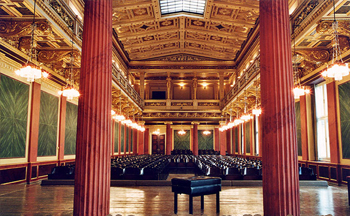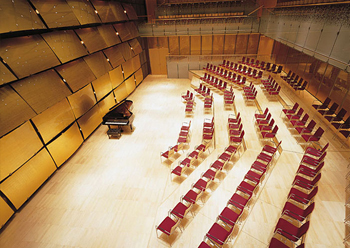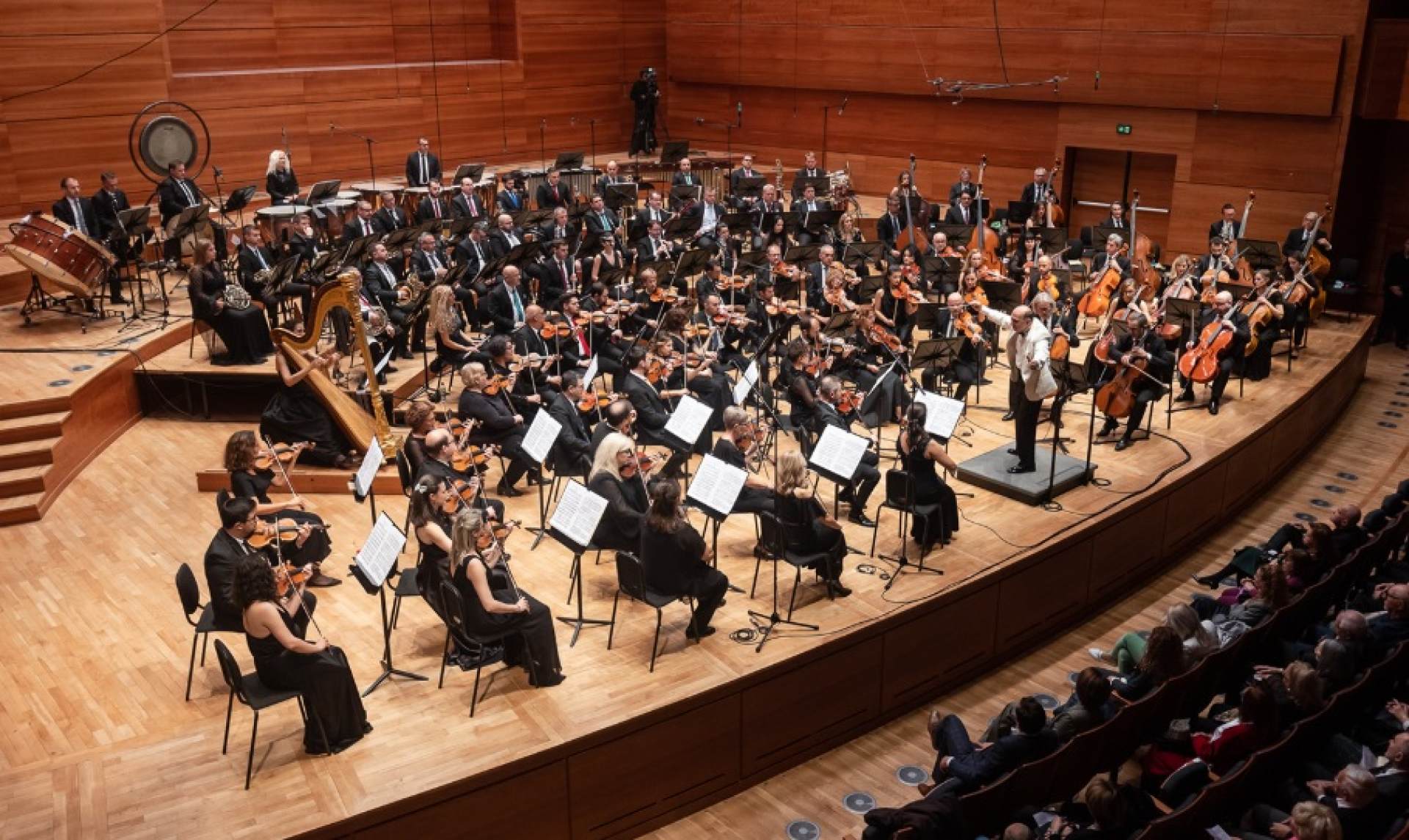Philharmonic Orchestra of North Macedonia
Mo | Tu | We | Th | Fr | Sa | Su |
For over seven decades, the Philharmonic Orchestra of North Macedonia has been the unique representative of symphonic music in North Macedonia. Founded on November 24, 1944, the first conductors of the orchestra were the Macedonian composers Todor Skalovski and Trajko Prokopiev. They were followed by numerous renowned Macedonian and international conductors.
Today, the Philharmonic Orchestra is a modern ensemble with over 90 permanent musicians, offering top-class musical performances to audiences in North Macedonia. Over the past seven decades, outstanding conductors have worked with the orchestra, including Lovro Matačić, Neeme Järvi, Igor Markevitch, Pavle Dešpalj, Tadeusz Kozlowski, Veronika Dudarova, Yuri Temirkanov, Janusz Przybylski, Leonid Nikolaev, Ramiz Melik Aslanov, Stefan Lano, Uroš Lajovic, Case Scaglione, Emil Tabakov, Daniel Raiskin, Krzysztof Penderecki, Timothy Redmond, Vladimir Ashkenazy, Sasha Nikolovski-Gjumar, Borjan Canev and many more.
Significant soloists have also appeared with the orchestra, including André Navarra, Leonid Kogan, Henryk Szeryng, José Carreras, Jessye Norman, Tzimon Barto, Akiko Suwanai, Jean-Efflam Bavouzet, David Garrett, Yulianna Avdeeva, Johannes Moser, Emmanuel Pahud, Torleif Thedéen, Ilya Gringolts, Isabelle Faust, David Fray, Lucas Debargue, Fazıl Say, Alexander Melnikov, Emmanuel Ceysson, Daniel Müller-Schott, George Li, Philippe Bernold, Nicolas Altstaedt, Ning Feng, Valery Sokolov, Boris Berezovsky, Evgeny Koroliov, Valentina Lisitsa, Julian Rachlin, István Várdai, Sayaka Shoji, Midori Gotō, Ana Durlovski and Simon Trpčeski, to name but a few.
The Philharmonic Orchestra has undertaken numerous tours to the countries of the former Yugoslavia and the former Soviet Union as well as to South America, Sweden, Turkey, the Netherlands, Italy, Romania, Switzerland and, more recently, to the Sultanate of Oman, Poland, Croatia, Israel, Spain, France and Austria.
Program and cast
Performers
Philharmonic Orchestra of North Macedonia, Orchestra
Yeruham Scharovsky, Conductor
Ana Durlovski, Soprano
Igor Durlovski, Bass
Program
Bete Ilin
Macedonian Paraphrase No. 2
Gligor Smokvarski
Teshkoto
Traditional
Five Macedonian Songs, arranged by Soni Petrovski
– Intermission –
Antonín Dvořák
Symphony No. 8 in G major, Op. 88
Ends approx. 22:00
Musikverein Golden Hall
This building is located on Dumbastraße/Bösendorferstraße behind the Hotel Imperial near the Ringstraße boulevard and the Wien River, between Bösendorferstraße and Karlsplatz. However, since Bösendorferstraße is a relatively small street, the building is better known as being between Karlsplatz and Kärntner Ring (part of Ringstraße loop). It was erected as the new concert hall run by the Gesellschaft der Musikfreunde, on a piece of land provided by Emperor Franz Joseph I of Austria in 1863. The plans were designed by Danish architect Theophil Hansen in the Neoclassical style of an ancient Greek temple, including a concert hall as well as a smaller chamber music hall. The building was inaugurated on 6 January, 1870. A major donor was Nikolaus Dumba whose name the Austrian government gave to one of the streets surrounding the Musikverein.
Great Hall - Golden Hall
 “As high as any expectations could be, they would still be exceeded by the first impression of the hall which displays an architectural beauty and a stylish splendour making it the only one of its kind.” This was the reaction of the press to the opening of the new Musikverein building and the first concert in the Großer Musikvereinssaal on 6 January 1870.
“As high as any expectations could be, they would still be exceeded by the first impression of the hall which displays an architectural beauty and a stylish splendour making it the only one of its kind.” This was the reaction of the press to the opening of the new Musikverein building and the first concert in the Großer Musikvereinssaal on 6 January 1870.
The impression must have been overwhelming – so overwhelming that Vienna’s leading critic, Eduard Hanslick, irritatingly brought up the question of whether this Großer Musikvereinssaal “was not too sparkling and magnificent for a concert hall”. “From all sides spring gold and colours.”
Brahms Hall
 "In order not to promise too much it can be said that it has been made into the most beautiful, most magnificent, perfect example of a chamber concert hall that any of us knows in the world.” This was the reaction of a Vienna daily newspaper in October 1993 as the Brahms-Saal was presented to the public after extensive renovation work.
"In order not to promise too much it can be said that it has been made into the most beautiful, most magnificent, perfect example of a chamber concert hall that any of us knows in the world.” This was the reaction of a Vienna daily newspaper in October 1993 as the Brahms-Saal was presented to the public after extensive renovation work.
The surprise was perfect. It was a completely new hall. In contrast to the Grosse Musikvereinssaal, the Brahms-Saal had changed its appearance quite considerably over the years. When and how it acquired that slightly melancholy duskiness that was known to music lovers before 1993 cannot be precisely documented.
Glass Hall
 As a venue for events from concerts to luxury banquets, the Glass Hall / Magna Auditorium is not only the largest of the Musikverein's 4 new halls but also the most flexible in terms of usage.
As a venue for events from concerts to luxury banquets, the Glass Hall / Magna Auditorium is not only the largest of the Musikverein's 4 new halls but also the most flexible in terms of usage.
Hub podiums enable the smooth transformation of the concert hall into a conference centre, the cinema into a ballroom, or the stage into a catwalk. State-of-the-art equipment for sound, lighting, video and widescreen digital projection provide the ideal conditions for half-scenic productions.
The Glass Hall / Magna Auditorium was designed by the Viennese architect Wilhelm Holzbauer. With a height of 8 metres, the hall (including the gallery) can play host to up to 380 visitors.

 EN
EN DE
DE IT
IT FR
FR ES
ES RU
RU JP
JP RO
RO
 Seating plan
Seating plan 

